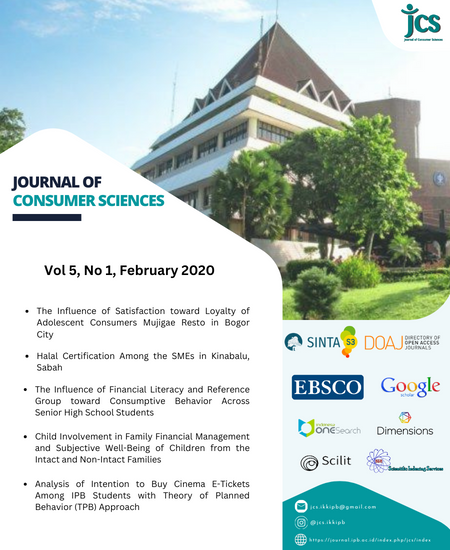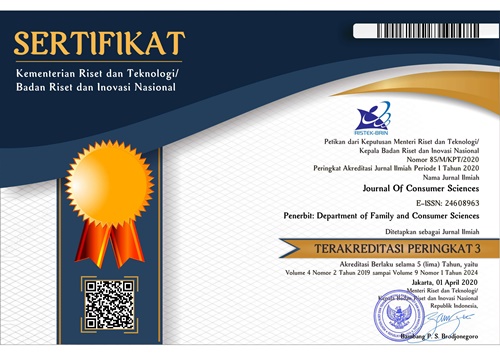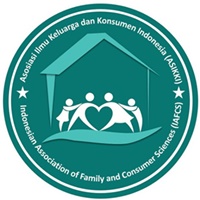The Influence of Financial Literacy and Reference Group toward Consumptive Behavior Across Senior High School Students
Abstract
Consumptive behavior is the tendency to buy goods or services without rational consideration. This study aims to analyze the influence of financial literacy and reference groups toward consumptive behavior across senior high school students. The study used a cross-sectional design and the research location was selected purposively based on the distance of the school from the shopping center area. Using the self-administered questionnaire, the study involved 125 students of public high school (SMAN) at Bogor City, that is SMAN 3 and SMAN 9. The data were analyzed using descriptive analysis and inferential statistics. The study showed that the level of financial literacy was in the medium category, while the reference group and the level of consumptive behavior were in a low category. Moreover, results indicated a relationship between the characteristics of adolescents, financial literacy, reference groups, and consumptive behavior. The regression test found a significant negative effect of financial behavior toward consumptive behavior. Females were more likely to be more consumptive, while reference groups positively influenced the consumptive behavior of senior high school students.
References
Afiati, B. (2016). Pengaruh status sosial ekonomi orang tua dan kelompok teman sebaya terhadap perilaku konsumsi siswa kelas XI IPS MAN Sidoarjo. Jurnal Pendidikan Ekonomi (JUPE), 2(3).
Ajzen, I. (2002). Perceived behavioral control, self-efficacy, locus of control, and the theory of planned behavior. Journal of Applied Social Psychology, 32, 665–683.
Amagir, A., Groot, W., Brink, H. M., & Wilchut, A. (2017). Financial literacy of high school students in netherland: knowledge, attitudes, self-efficacy, and behavior (Tier Working Paper Series TIER WP 17/18). Retrieved from http://www.tierweb.nl/tier/assets/files/working_papers/TIER%20WP%2017-18.pdf.
Atkinson, A., & Messy, F. A. (2012). Measuring financial literacy: results of the OECD/international network on financial education (INFE) pilot study. OECD Working Papers on Finance, Insurance and Private Pensions 15, OECD Publishing. https://doi.org/10.1787/5k9csfs90fr4-en
Avello, M., Gavilan, D., Blasco, F., & Abril, C. (2010). Hedonic buying motivation and time-style. The International Journal of Management and Bussiness, 1(1), 128-155.
Chan, K. (2003). Materialism among Chinese children in Hong Kong. Young Consumers, 4(4), 47-61. https://doi.org/10.1108/17473610310813988
Chatijah, S., & Purwadi. (2007). Hubungan antara religiusitas dengan sikap konsumtif remaja. Humanitas, 4(2), 110-123.
Chen, H., & Volpe, R. P. (1998). An analysis of personal financial literacy among college students. Financial services review, 7(2), 107-128.
Chita, R. C. M., David, L., & Pali, C. (2015). Hubungan antara self-control dengan perilaku konsumtif online shoping produk fashion pada mahasiswa Fakultas Kedokteran Universitas SAM Ratulangi angkatan 2011. Jurnal eBm, 3(1), 297-302.
Dikria, O., & Mintarti, S. U. (2016). Pengaruh Literasi Keuangan Dan Pengendalian Diri Terhadap Perilaku Konsumtif Mahasiswa Jurusan Ekonomi Pembangunan Fakultas Ekonomi Universitas Negeri Malang Angkatan 2013. Jurnal Pendidikan Ekonomi, 9 (2), 143-155.
Engel, J. F., Blackwell, R. D., & Miniard, P. W. (1994). Perilaku Konsumen (Jilid 1). (Budiyanto, Trans.). Tangerang: Binarupa Aksara Publisher.
Fattah, F. A., Indriayu, M., & Sunarto, S. (2018). Pengaruh literasi keuangan dan pengendalian diriterhadap perilaku konsumtif siswa SMA Muhammadiyah 1 Karanganyar. BISE: Jurnal Pendidikan Bisnis dan Ekonomi, 4(1), 11-21. https://doi.org/10.20961/bise.v4i1.20028
Financial Services Authority. (2017). Survei Nasional Literasi dan Inklusi Keuangan edisi revisi. Jakarta: Otoritas Jasa Keuangan.
Financial Services Authority. (2019). Statistik fintech lending period Mei 2019. Retrieved from https://www.ojk.go.id/id/kanal/iknb/data-dan-statistik/fintech/Pages/Statistik-Fintech-Lending-Periode-Mei-2019.aspx. (July 22, 2019)
Gumanti, D., Sari, P. M., & Putri, Y. E. (2017). Pengaruh pendapatan, kelompok referensi, literasi ekonomi, dan sertifikasi guru terhadap perilaku konsumsi guru SD, SMP, dan SMA di Kecamatan Gunung Talang Kabupaten Solok. Journal of Economic and Economic Education, 6(1), 55-65. https://doi.org/10.22202/economica.2017.v6.i1.2323
Ham, M., Jeger, M., & Ivković, A, F. (2015). The role of subjective norms in forming the intention to purchase green food. Economic Research-Ekonomska Istraživanja, 28 (1), 738-748, DOI: 10.1080/1331677X.2015.1083875
Hamzah, A., Hamzah, S. R., Krauss, S. E., Suandi, T., & Tamam, E. (2013). The moderating effect of parent and peer influences on hedonistic behavior among undergraduate students in Malaysia. Journal of Asian Social Science, 9(13), 137-146.
Hartatin, D., & Simanjuntak, M. (2016). The effect of value and reference group on young consumer’s hedonic buying. Journal of Consumer Sciences, 1(1), 33-46. https://doi.org/10.29244/jcs.1.1.33-46
Hastuti, D. (2015). Pengasuhan Teori Prinsip dan Aplikasinya di Indonesia. Bogor: IPB Press.
Hotpascaman, S. (2010). Hubungan antara perilaku konsumtif dengan konformitas pada remaja (Undergraduate Thesis, Universitas Sumatera Utara, Medan, Indonesia). Retrieved from http://repository.usu.ac.id/handle/123456789/14510.
Imawati, I., Susilaningsih., & Ivada, E. (2013). Pengaruh financial literacy terhadap perilaku konsumtif remaja pada program IPS SMA Negeri 1 Surakarta. Jupe UNS, 2(1), 48-58.
Indarjo, S. (2009). Kesehatan jiwa remaja. Jurnal Kesehatan Masyarakat, 5(1), 48-57.
Kaul, S. (2007). Hedonism and culture: impact on shopping behavior a research agenda. Vikalpa, 32(3), 81-89. https://doi.org/10.1177/0256090920070306
Kusumaningtyas, I., & Sakti, N. C. (2017). Pengaruh literasi keuangan dan gaya hidup terhadap perilaku konsumtif siswa kelas XI IPS di SMA negeri 1 Taman Sidoarjo. JPE, 5(3), 1-8.
Kusumowidagdo, A. (2010). Pengaruh desain atmosfer toko terhadap perilaku belanja. Jurnal Manajemen Bisnis, 3(1), 17-32.
Lina & Rosyid, H. F. (1997). Perilaku konsumtif berdasar locus of control pada remaja putri. Psikologika, 4(1), 5-13. https://doi.org/10.20885/psikologika.vol2.iss4.art1
Lusardi , A., Mitchell , O. S., & Curto, V. (2009). Financial literacy among the young. Journal of Consumer Affairs, 44, 358-380. https://doi.org/10.1111/j.1745-6606.2010.01173.x
Maulana, M. A. (2018). Pengaruh literasi keuangan, pengendalian diri, dan penggunaan media sosial terhadap perilaku konsumtif (Undergraduate Thesis, IPB University, Bogor, Indonesia). Retrieved from https://repository.ipb.ac.id/handle/123456789/96441.
Mawo, T., Thomas, P., & Sunarto. (2017). Pengaruh literasi keuangan, konsep diri, dan budaya terhadap perilaku konsumtif sisa SMAN 1 Kota Bajawa. Journal of Economic Education, 6(1), 60-65.
Nurachma, Y. A., & Arief, S. (2017). Pengaruh status sosial ekonomi orang tua, kelompok teman sebaya dan financial literacy terhadap perilaku konsumtif pada siswa kelas XI IPS SMA Kesatrian 1 Semarang. Economic Education Analysis Journal, 6(2), 489-500.
Organization for Economic Cooperation and Development. (2016). PISA 2015 PISA Result in Focus.
Opoku, A. (2015). Financial literacy among senior high school students: evidence in Ghana (Master Thesis, Kwame Nkrumah University, Kabwe, Ghana). Retrieved from http://ir.knust.edu.gh/xmlui/handle/123456789/8511
Permatahati, D. I. (2013). Pengaruh gaya hidup, kelompok acuan, dan sikap terhadap pembelian produk makanan kemasan (Undergraduate Thesis, IPB University, Bogor, Indonesia). Retrieved from https://repository.ipb.ac.id/handle/123456789/67380
Pham, T. H., Yap, K. & Dowling, N. A. (2012). The impact of financial management practices and financial attitudes on the relationship between materialism and compulsive buying. Journal of Economic Psychology, 33, 461-470.
Pramudi, R. Y. (2015). Pengaruh gaya hidup konsumtif dan kelompok referensi terhadap keputusan pembelian kosmetik lokal. Journal of Research in Economics and Management, 15(2), 280-301
Ramadhan, A. F., & Simanjuntak, M. (2018). Perilaku pembelian hedonis generasi z: promosi pemasaran, kelompok acuan, dan konsep diri. Jurnal Ilmu Keluarga & Konsumen, 11(3), 243-254. https://doi.org/10.24156/jikk.2018.11.3.243
Ramdhani, N. (2011). Penyusunan alat pengukur berbasis theory of planned behavior. Buletin Psikologi, 19(2), 55-69.
Rapih, S. (2016). Pendidikan literasi keuangan pada anak: mengapa dan bagaimana?. Scholaria, 6(2), 14-28.
Schiffman, L. G., & Kanuk, L. L. (2004). Consumer Behavior (8th ed.). New Jersey: Prentice-Hall.
Setiadi, N. J. (2008). Perilaku Konsumen; Konsep dan Implikasi Untuk Strategi dan Penelitian Pemasaran. Jakarta: Kencana.
Setiawati., & Nurkhin, A. (2017). Pengujian dimensi konstruk literasi keuangan mahasiswa. Economic Education Analysis Journal, 6(3), 727-736.
Sofia, N., & Irianto, A. (2016). Pengaruh pendapatan orang tua, kelompok acuan, dan hasil belajar ekonomi terhadap literasi keuangan mahasiswa fakultas ekonomi Universitas Negeri Padang. Jurnal Kajian Pendidikan Ekonomi, 2-18.
Sumarwan, U. (2015). Perilaku Konsumen; Teori dan Penerapannya dalam Pemasaran. Jakarta: Ghalia Indonesia.
Turcinkova, J., & Moisidis, J. (2011). Impact of reference groups on the teenagers’ buying process of clothing in the Czech Republic. Mendel Burn, 59(7), 489-496.
Wagner. (2009). Gaya hidup “shopping mall” sebagai bentuk perilaku konsumtif pada remaja di perkotaan (Undergraduate Thesis, IPB University, Bogor, Indonesia). Retrieved from https://repository.ipb.ac.id/handle/123456789/12504.
Wahyudi. (2013). Tinjauan tentang perilaku konsumtif remaja pengunjung mall Samarinda. eJournal Sosiologi, 1(4), 26-36.
Authors who publish with this journal agree to the following terms:
- Authors retain copyright and grant the journal right of first publication with the work simultaneously licensed under a

This work is licensed under a Creative Commons Attribution 4.0 International License. that allows others to share the work with an acknowledgement of the work's authorship and initial publication in this journal. - Authors are able to enter into separate, additional contractual arrangements for the non-exclusive distribution of the journal's published version of the work (e.g., post it to an institutional repository or publish it in a book), with an acknowledgement of its initial publication in this journal.
- Authors are permitted and encouraged to post their work online (e.g., in institutional repositories or on their website) prior to and during the submission process, as it can lead to productive exchanges, as well as earlier and greater citation of published work (See The Effect of Open Access).











